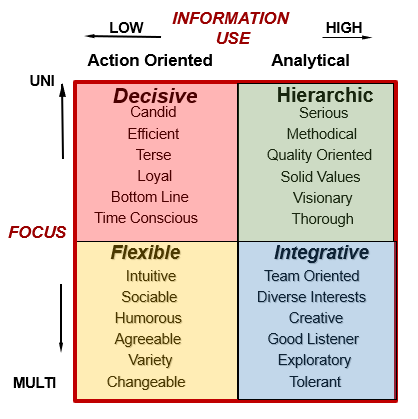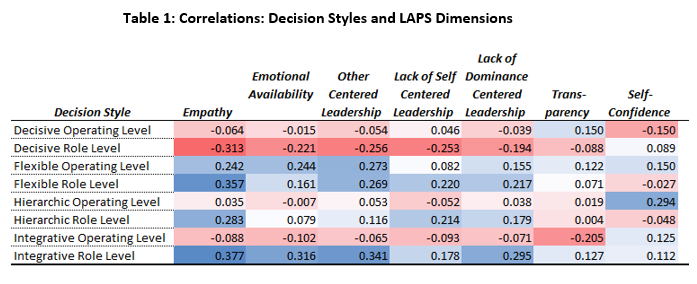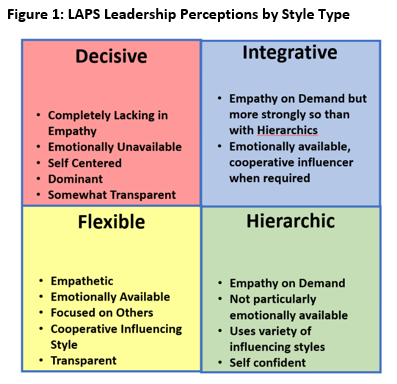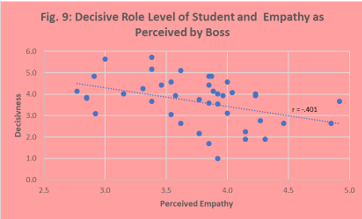Perils and Pitfalls in Navigating the Career Crossroads
By Philip Janson, Ph.D., President, The Mahler Co., [email protected], © The Mahler Co. Research Note
Introduction
Divining the characteristics of successful leaders has preoccupied us for eternity. If Adam had been less self-centered and more strategic in his thinking…. where would we be today? Or if Napoleon had perhaps been more analytical in logistical planning for the invasion of Russia and less decisive, we might all be speaking French today! Whatever the historical referent, we have long understood that we are a social species, less dependent upon chemical drivers and more dependent on the relationship formed between a leader and those who enable his or her ambitions.
The language describing the characteristics of successful leaders has been consistent in its use of the charismatic “great man” hypothesis. Academics have tried to untangle the meaning of charisma since Max Weber’s 19th century codification of charisma as a
“certain quality of an individual personality by virtue of which he is set apart from ordinary men and treated as endowed with supernatural, superhuman or at least specifically exceptional powers or qualities. These are such as are not accessible to the ordinary person but are regarded as of divine origin…”[1]
Modern references to Charlemagne cite his strategic ability (he made the siege into a replicable methodology thereby staunchly defending and promoting Roman Christianity, winning a crucial alliance with Pope Leo III), his tactical smarts (delegation to regional government administrations) and team building (annual conferences of regional administrators).[2]
Barack Obama was described as “logical”, embracing “change we can believe in”[3] and as having Integrity, Respect, Fairness, Confidence and Mindful Decision-Making[4]. In the aftermath of the historic ascendance of the first African American to the highest office, the Harvard Business Review used Weber’s charisma to summarize his appeal as “the man whose silver tongue had moved many to the point of tears, had moved them to move mountains to make him president.”[5]
I cite these examples because they illustrate how elusive leadership is as a concept and how susceptible any attempt at rigor in describing it is to the “great man” hypothesis. This is certainly true regarding biographies and especially autobiographies summarizing “great man” leadership at the conclusion of a career[6][7][8]. The problem with such “great man” data points is they ignore the subtle shifts in style required of leaders as they traverse what Walt Mahler described as “The Career Crossroads”. In this model, the behaviors required of leaders are different depending on whether they are managing projects or managing an enterprise. That a CEO is highly decisive and action oriented, for example, says nothing of her style when she was a functional leader earlier in her career. The conundrum is summed up nicely by what a colleague once said after I opined that a young staffer at an accounting firm would make a great partner. The reply was, “yes, as long as he can make it as a senior consultant”. Behaviors matter and are specific to one’s level.
In this paper, I will describe a robust, 21st century theory of leadership effectiveness and use this model to explore the origins of how leaders are perceived by bosses, peers and direct reports using results from a 360 survey of leadership effectiveness. The motivation for this inquiry stems from the often conflicting advice gleaned from the often conflicting advice of leadership biographies, theories and self help career books. Some focus aspiring leaders on how to be decisive.[9] [10] Others on being a “servant leader”. [11] Still others argue the merits of being a flexible leader [12]. These are the concepts we will explore in this analysis.
Decision Styles and Leadership Effectiveness
The Mahler Co. has been using the work of Mike Driver and Ken Brousseau and their firm, Decision Dynamics in our leadership practice for many years. We were looking for an assessment that could predict effective leadership behavior and to help our students understand some of the behaviors that might predict their success.
The model focuses on how people in general and leaders in particular make decisions. It is a conceptually simple model, with a fundamental premise and profound implications for leadership behavior. Graduates of our Executive Leadership Program and our Advance Management Skills Program will recall the model.
Conceptual Model
First, according to Brousseau[13] and his colleagues, the decision style model entails two key variables. How much information one requires to make a decision and how many things one focuses on at once.
How Much Information: Does a leader require reams of data, spreadsheets and meetings to decide? Or is s/he comfortable with enough data to provide a good gut feeling.
How Many Things Focused On: Is multitasking the intellectual order of the day, or is it focus and solve one at a time…or something in between?
These two variables result in a behavioral typology which together define four basic styles[14].

Decision Styles Conceptual Model
A Fundamental Premise
Unlike any other assessment we have ever seen…and what initially drew us to this model…is the idea that there are elements of our leadership behavior that we are fully aware of, our Role Style, and those elements which are so ingrained in our behavior or which come out when we are supremely comfortable or confident known as our Operating Style. A corollary of this premise is that if one is aware of one’s Role Style, one has control over that style. Thoughtful leaders can “dial up” those behaviors that seem normative in the company culture. We have often observed that people imitate those in power. This is a reflection of what we believe the rules or norms are in the culture.
On the other hand, Operating Style may be far less observable to the person exhibiting it. Operating Style is what we use when we are alone or with a team that we are quite comfortable with. This is the style we use when we are operating or just getting our jobs done.
Implications for Leadership
What we find quite interesting about this model are the implications of behaviors we are aware of and those we are not aware of. Accurate self-reflection in concert with accurate diagnosis of the culture we live in can help us choose a Role Style that is positively perceived within that organization’s culture and that will foster our leadership credentials. Role Style is the most straightforward path to controlling how others perceive us.
On the other hand, with Operating Style, the 2AM use of the “enter key” can launch emails (copy all, anyone?) that come back to bite us. Or the tendency to tell one’s team, “the hell with it, let’s just do it” can bring untoward consequences if the stakes are high and the analytical depth shallow. Operating Style is a much more challenging lever with which to control how we are perceived. The unconscious nature of this style is based on lifelong learning that has taught us how to act in certain situations, but not all.
In addition to the Decision Styles assessment, we have used 360 surveys in our classes for over fifty years. We use these to help people understand what kind of coach they are for their people, or what kind of team leader they are. We help them see that how they are perceived is more important than how they want to be perceived. Perception is reality, goes the refrain.
Several years ago, we developed a 360 survey that measures Leadership Acumen. This Leadership Acumen Profile (LAP) survey measures seven core dimensions of leadership behavior: Empathy, Emotional Availability, Other-Centered Leadership, Self- Centered Leadership, Power-Oriented Leadership, Transparency and Self-Confidence. As we accumulated data, we began to look for clear patterns that indicate the consequences, both positive and negative, for certain decision style preferences.
Responses are recorded on a Likert scale from 1 (Strongly Disagree) to 6 (Strongly Agree). Responses are recorded for the student (self), direct reports, bosses and peers.
Table 1 shows the Pearson correlations for the relationship of Role and Operating Styles and the seven LAP survey dimensions. The colors indicate the direction and intensity of the relationship. The sample consists of 51 senior managers who were students in a yearlong executive education class. These 51 individuals were rated by a total of 731 raters who were either direct reports, peers or bosses. The students were employed in a range of manufacturing and service companies. Ratings were excluded if students were not well known by their raters.

If one had to bet on which styles would predict positive perceptions of one’s leadership style, one would likely choose a combination of flexible and integrative role styles. There is a preponderance of positive correlations (blue). The flexible style is a caring sort of style in which people feel safe in the presence of a leader. It is social in that the leader is willing to listen and contribute to discussions about things that are fun and engaging. Their comfort in listening to input and changing course to match that input is inherently honoring of the perspective of others.
The general pattern of colors indicates the highest overall positive correlations between Integrative Role Style and the LAPS Survey dimensions. Leaders who have a preference for an Integrative Role style are those who will seek out others’ viewpoints. Such leaders tend to be quite good at honoring individual contributions to decision making, selecting the best the group has to offer and giving credit where it is due. The Integrative style in general is a highly analytical style. It values decision quality over speed and recognizes that the power of the team is always greater than the power of individuals on the team. The strongest correlation is with Empathy, followed by Emotional Availability and the use of Other Centered Leadership.
Flexible Role Level is nearly as strongly correlated with Empathy and less so for the other LAPS Dimensions.
The Hierarchic Role Level correlates highly with Empathy and (the lack of) Self Centered Leadership.
We find quite striking the strong negative correlation between the Decisive Role Level and Empathy. It is strongly negative for three of the other LAPS Dimensions as well (Emotional Availability, Other Centered Leadership and Self-Centered Leadership). We are also quite struck by the stronger correlations between Role Styles and LAPS Survey Dimensions than for Operating Styles.
Likewise, the integrative style, at least in role style is well correlated with Empathy, Emotional Availability, Other Centered Leadership and the lack of Dominance Centered Leadership.
The hierarchic role style is predictive of empathy and the lack of self-centered leadership style.
Figure 1 summarizes the leadership characteristics of leaders by their style types.

The Myth of the Decisive Leader
The Leadership literature is vast, and any summary statements made about it run the risk of over simplification. This is certainly true about the statement we are about to make. In most lists of effective leadership qualities, Decisiveness ranks in the top five. Based on what we have found, one must be very careful about what one asks for. The Decisive style is not an analytical style. It is borne of a belief that prioritizes action over thoughtfulness and the idea (hope?) that one can always correct in case one is initially wrong.
The myth component of decisiveness as a leadership quality is derived from the frustration at the often-slow pace of activity in modern complex organizations. Incoming CEO’s typically form quick diagnoses and then act on the diagnosis by rebuilding the executive ranks. The only slowness in the process of taking charge is due to the recruitment / selection / outplacement time line. There is typically little room at the top for caring about the outgoing executives, for the traditions and values that defined the old culture or for patience in the face of resistance.
The challenge lies in how one prepares for the CEO role. Jack Welch’s widely publicized career offers a few clues. As a rising Ph.D. Chemical Engineer in the plastics division, he learned to manager others the GE way with regular performance evaluations, long range planning and hiring the best people. He rose through the ranks by displaying level appropriate behavior and leadership practices. When he took charge, there was little need for lengthy diagnosis since he was an insider…an insider who was frustrated by the slow pace of change. Thus was borne, “Neutron Jack”, the emerging CEO who delayered and downsized an organization that was encumbered by bureaucracy and tradition. Reading his books gives one the sense of a leader who bided his time, betting on one day achieving the top job. Leaders in these roles often encounter a skeptical business press when they decisively state that they have no time for strategy, as Welch did early in the job.
Interestingly, the large volume of Welch’s work in his later years displays a leader looking back over a career which spanned the whole range of styles we discuss in this paper. He used those styles that were needed for the role he played at the time. Based on the data presented in this paper, it is likely that if he overused the decisive style earlier in his career, he would not have become CEO.
We have seen examples in our coaching practice in which job candidates are selected and hired by leaders who have seen the candidate’s decisive profile and verbalize a preference for that individual over a similarly qualified candidate who predominated with say a hierarchical or integrative style. All too often, the hiring manager subsequently (sometimes years later) laments the candidate’s lack of thoughtful integration with the perspective of the rest of the team. We have even seen decisive candidates hired by decisive leaders with ultimately terrible results. Based on the Leadership Perceptions summarized in Figure 1, we believe we see why Decisiveness, at least as measured by Role Style could produce sub-optimal organizational outcomes.
Discussion
There are two implications of this research. The first is that any style can have a positive impact on whether a leader is perceived positively, except that is, for the Decisive Style. The Decisive style is dangerous to overuse. Decisiveness is a predictor of best in class performance, interestingly enough at the earliest management level, that of a supervisor, and at the top job, CEO . For all jobs in between, success is predicted by other styles, not decisiveness.
The second implication is that Role Style is more strongly correlated with the leadership perceptions used in this study than Operating Style, except for the Flexible style. It may be that the power one has to influence one’s career success lies predominantly in the use of Role style since this is the one we are aware of. The implication is that career success may be difficult unless one remains “in role”, that is conscious of the perceptual requirements of one’s action plan. The level of career strategy and the energy it takes seems quite daunting from this perspective.
So, that’s what the statistics suggest. How about our experience?
Over the years we have seen a number of instances that illustrate this negative relationship between decisiveness in an individual and negative interpersonal outcomes. The two examples illustrated here are both in the HR functions, precisely where one would think soft skills are most important.
In one client, a manufacturer of vitamin supplements, we were asked to interview a candidate for the VP position in Human Resources. As part of that process, we administered the Decision Styles assessment. We found an unusually high level of Decisiveness in the candidate. In addition, the interview revealed a lack of depth of insight in the candidate. We contacted the President who commissioned us to express our reservations and were told, “Oh heck, I just pulled the trigger. I’m sure he’s a good hire”.
Well, it turns out that the company President’s style was “double decisive”: High decisive in both role and operating style. So, we held our reservations and over the next two years watched the complete failure of the new VP HR. It took four years to fire him and to promote one of the internal candidates who was passed over.
A second example, also in HR, is about a growing financial institution with a high need for professional HR guidance.
This time, the candidate interviewed with a certain “edge”, that is, a kind of verbal reluctance to engage interpersonally until it was understood that this was in her interest. The assessment showed an unusual preference for decisiveness in Role Style. However, her experience was deep, and it seemed that she brought what we call strong “back wheel” or HR disciplinary skills and experience to the job. However, the assessment pointed to a possible lack of client focus, inclusiveness and collaborative problem solving “front wheel” skills.
When we discussed this with the company President, we were told that he really wanted to hire her. And he did. He too was a “doubly decisive” company President.
Four months into the mission, we began to hear stories of divisive intrusions into line manager decisions on interviewing, hiring decisions, job documentation and compensation. There was a very strong “my way or the highway” component to her interaction with peers. In one hiring case we heard about, she made a compensation decision and offer to a candidate that was $25,000 higher than the candidate told the line manager she needed. The line manager felt intimidated by the HR Director and failed to intervene before the offer was made. In other situations, job titles were upgraded or downgraded based on compensation levels despite the fact that the jobs were identical. This led to team design issues when it came to formulating team charters and individual responsibilities.
In one critical incident, a line manager with responsibility for 50% of the organization was told to develop job descriptions and fast. The HR Director was feeling the tick of the clock when regarding professionalizing the HR function and its impact on the company.
The line manager was very uncomfortable about this. When we probed, it was evident that the HR Director had not learned that the line manager was in the process of designing a team-based organization around customer types. In addition, these teams would be as self-directed as possible. The situation: A highly decisive HR Director who had failed to integrate her perspective with her internal clients, was striking out on her own and driving her own agenda that happened to be 180 degrees off the company’s true north. She was intolerant of ambiguity, of others’ viewpoints, lacked empathy and the ability to drive strategic change. She was terminated after six months.
Role vs. Operating Style in Rater Perceptions
One way to make sense of the greater power of Role Style is to view it as a planned and purposeful response to one’s read of the corporate culture. It is, quite simply, conscious and more often than not, public. There are many dynamics at play here. For one, it is quite common for role and operating styles to differ. This can be confusing without some purposeful actions on the part of the person being perceived. We often coach our students to use a meeting planner to identify the nature of the meeting and the dominant style that will evoke the right combination of exploration, involvement of others, concern for others’ feelings and action.
The data tend to indicate that the highly social Flexible Style works well to convey a sense of caring and concern for the contributions of others. And the fact that the highly analytical Hierarchic Style can be used artfully to let people know that the leader has empathy for them suggests that if one knows that this outcome is desired, it can be produced by conscious behavior. And the Integrative Style with its proclivity for reaching out to others for their input seems to naturally convey a sense of Empathy.
The negative correlations for Decisive Role style remind us a little of the Pixar character, Anger from the movie Inside Out. This character is the epitome of what we are increasingly seeing as the dark side of decisiveness. He is one of the five emotions of an 11-year-old girl named Riley. Together with his peers (Joy, Disgust, Fear and Sadness) he influences Riley’s responses to life’s conundrums. When he finally takes control, pushing buttons and flipping levers and switches, he produces near disaster, recoverable only by the swift intervention of the other emotions.
We often find bosses wishing out loud that their people were more decisive. They seem to crave action and are sometimes quite frustrated by the tendency to over analyze. We were quite surprised when we ran the analysis in Fig. 9. Here we see one of the strongest negative correlations between Decisive Role Style and Perceived Empathy. Here, the population is restricted to the Boss’s perception of the student’s level of empathy.

The negative relationship holds for all rater groups but is strongest for Bosses. Apparently even those who crave action recognize that action without thought, care and a focus on the cultural implications of that action will have difficulty achieving results.
